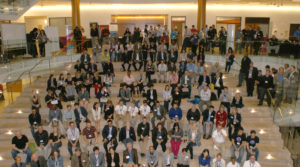
AirZaar Is Reinterpreting Drone Intelligence
It's no secret that drones are set to play a big part in our future, and St. Louis-based AirZaar is on the forefront of the new technology.
It’s no secret that drones are set to play a big part in our future, and St. Louis-based AirZaar is on the forefront of the new technology, using its cloud-based business platform to help companies use drones to collect and analyze data that helps them make “actionable decisions.”
Basically, AirZaar is the commercial world’s one-stop-shop when it comes to drone management. Using one platform—its cloud-based software—the company can help manage and automate everything from flight planning to FAA compliance to translating the visual intelligence the drones gather into useful information and insights.
“At AirZaar our mission is to derive real-time visual intelligence from the physical world,” says Ali Ahmadi, co-founder and COO. And it works with any drone, whether a company is contracting them out or has their own internal fleet.
“AirZaar’s name was derived from the thought of an aerial bazaar,” says Ahmadi. “Our goal is to empower and connect industrial clients to resources needed for their aerial data analytics needs.”

Ahmadi met AirZaar’s other co-founder (now CEO) Ravi Sahu, when both of them were working on their EMBA degrees at Washington University. They began collaborating on problems they saw existing in the drone world, and it was Sahu who really kickstarted the company:
“His inspiration came when he spent time with a South American client, a Fortune 500 company trying to implement drone data into its infrastructure,” says Ahmadi.
“He then went through a Silicon Valley fellowship program that polished the idea. We then started collaborating on the conceptualization of the business.”
The two of them started AirZaar about a year ago, says Ahmadi. After “spending weeks and months in front of industrial clients that had immediate pain points,” says Ahmadi, they refined their concept. Along with design, the conceptual phase of the platform took more than four months to put together; followed by the development of their software, which took another four months.
Ahmadi credits his time in the military as the “No. 1 influencer” in prepping him for the startup world. “Being an entrepreneur is not easy. The mental, emotional, physical and financial stresses that come with trying to make a startup successful is not for everyone. Startup life is filled with moments and times of being told ‘No’ and still being able to get off the ground, dust yourself off and go along to the next target.”

And while AirBazaar doesn’t actually have its own drones, Ahmadi has hands-on experience with them himself. “As a US Navy aviator flying multiple drone platforms, my technical skills prepared me for the industry,” he says.
“More importantly, my time served in the military prepared me to always be cognizant of my surroundings, have strong situational awareness and be agile to the environment. These skills have been priceless in developing AirZaar to this point.”
After its months spent in development, “AirZaar has evolved into a platform to address immediate needs and pain points while integrating cutting-edge technologies of the future into legacy industries vying for innovation,” says Ahmadi.
Currently headquartered in St. Louis, the company also has additional offices in India, with a total of six full-time and three part-time employees.
Gathering Intelligence
Of course, AirZaar isn’t the only company in the burgeoning field. “Currently there are a couple of solutions in the market that we consider indirect competitors,” says Ahmadi. “However, the actual end-user pain points are not being addressed by these companies.”
AirZaar’s approach in solving pain points gets to the heart of the matter right off the bat: They go to end-users (their clients) to spend weeks and months experiencing their concerns right alongside them. It’s lead to innovation that makes the company’s platform unique—and stronger: “Every feature and product within our platform has been developed due to first-hand experiencing the pain alongside the clients ourselves,” says Ahmadi.
But what really makes the company stand out is their in-house software platform—because they built it themselves, they’ve been able to hone in on what really matters in the drone landscape: accuracy. “The core differentiator of our platform is the accuracy level we have been able to achieve within our visualization software,” says Ahmadi.
“We have built every single layer of our platform ourselves from the ground up instead of using an insufficient third-party option. This has allowed AirZaar to become the most accurate and enterprise-grade software in our industry.”
Getting the Word Out
One of the challenges of being at the forefront of a new industry is explaining exactly what your business does—especially when it’s not an easy category it fits in.
“A challenge that we had faced in the early days of our company was that we weren’t completely understood,” says Ahmadi. “Time and time after pitching to an audience, we kept being told that people still didn’t understand what our software really did for our clients.”
But it wasn’t just explaining what they were that was difficult—it was explaining what they weren’t. “We kept being boxed into a ‘drone software’ company,” says Ahmadi. “This was the farthest from reality in what our software really accomplished.”
“As a matter of fact, AirZaar doesn’t even own a drone or even touch any hardware. This was very hard for our audience to grasp.”
“We faced a huge challenge in the messaging of our company. How do you explain what AirZaar does without getting too technical?”
So the innovators got innovative. “After a lot of pain and frustration, we changed our messaging and pitch deck,” he says. “Additionally, we incorporated a demo video into our pitch deck to demonstrate a day in our client’s eyes using AirZaar.”
With the new approach of showing, instead of telling, the results were immediate, Ahmadi says. “We even got a mention in a Forbes article about our pitch.”
Analyzing the Data
Big things are in store for AirZaar: They’ve just partnered with a global company to distribute their platform internationally. Even bigger yet, they’ve partnered with drone manufacturers who will have AirZaar’s software installed in every drone they sell this year.
Ahmadi credits the above traction to the company’s strategy of “partnering with key organizations that are thought leaders in their industry instead of having to approach them heads on,” he says. “These partnerships have been key to us creating a sustainable revenue model.”
It’s thanks to these partnerships that Sahu and Ahmadi have been able to avoid taking on outside investments and have instead bootstrapped the company themselves. But still, “the most exciting factor of our platform is when a potential client demos our software and you can see the excitement in their eyes,” Ahmadi says.
And bigger things yet lie in store for the company: “Our next step is to integrate our platform with enterprise IT systems being used within the mining and construction industry,” says Ahmadi.
“The vision of AirZaar is to be a key enterprise software company addressing the needs of its clients for the mining, construction and infrastructure industries.”







